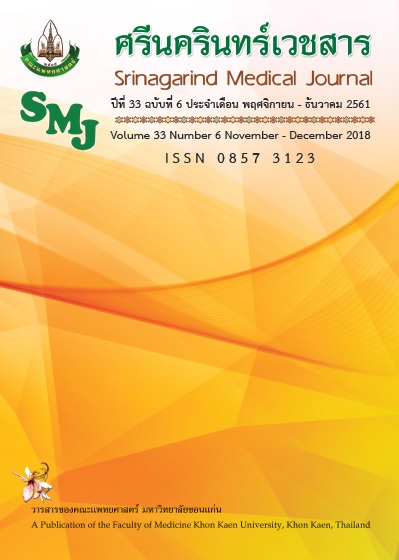A Follow-up Study of the Effects of Health Education Program by Using an Application of Protection Motivation and Social Support Theories on the Blood Pressure Control of the Hypertension Risk Groups
Keywords:
Health Education Program; Social support; Blood Pressure Control; Hypertension Risk GroupAbstract
Background and objectives: Hypertension is a silent killer cumulatively developed often without warning signs. Hence, since most people with hypertension are not aware of its presence, they do not practice appropriate health-promoting behaviors. The aims of this study were to investigate the effects of health education program through the application of protection motivation theory for disease control together with social supports on blood pressure control in the hypertension risk groups.
Methods: This quasi experimental research used one group repeated measures design. The studied samples was composed of 30 subjects aged between 35 and 59 chosen from the hypertension risk groups through purposive sampling as well as the verification against the eligibility criteria. The samples were engaged in 12-week health education program-oriented activities on a weekly basis. Subsequently 3, 6, and 7 months after the activities had ended, the researchers conducted the follow-up and evaluation sessions of behavioral continuity through a questionnaire. The samples’ blood pressure were measured and the descriptive and inferential statistics were used to analyze the data.
Results: The results of the health education program-oriented activities showed that the mean scores achieved 3 and 6 months after the activities had ended were significantly different (p < 0.001). The mean scores of perceived severity, perceived probability, perceived outcomes of health-protective behaviors regarding hypertension prevention, and the practice of the hypertension prevention tended to increase. The comparison of the mean scores of blood pressure measurements of individuals belonging to the hypertension risk groups before the participation in the activities and 7 months after the activities had ended showed that 86.7% could maintain their blood pressure at its normal level.
Conclusions: The health education program with the application of protection motivation theory together with social support has impacted on the development of health-protective behaviors regarding hypertension prevention both in the short and long run as well as assisted those in the hypertension risk groups in maintaining their blood pressure at its normal level.
References
2. ภานุวัฒน์ ปานเกศ, จุรีพร คงประเสริฐ, นิตยา ภัทรกรรม, นงนุช ตันติธรรม, ศุภวรรณ มโนสุนทร, พัชริดา ยิ่งอินทร์. รายงานการพยากรณ์โรคความดันโลหิตสูง. [เข้าถึงเมื่อ 5 เมษายน 2561]. เข้าถึงได้จาก: 2. file:///C:/Users/Administrator.7TVG2EQWID72J9G/Downloads/report_2012_11_no01%20(1).pdf.
3. วิชัย เอกพลาการ. (บรรณาธิการ). รายงานการสำรวจสุขภาพประชาชนไทยโดยการตรวจร่างกาย ครั้งที่ 5 พ.ศ. 2557. นนทบุรี: สถาบันวิจัยระบบสาธารณสุข, 2557.
4. สำนักงานกองทุนสนับสนุนการสร้างเสริมสุขภาพ. คนไทยป่วยความดันโลหิตสูง 11 ล้าน. [เข้าถึงเมื่อ 5 เมษายน 2561]. เข้าถึงได้จาก: http://www.thaihealth.or.th/microsite/content/5/ncds/181/24127-คนไทยป่วยความดันโลหิตสูง+11+ล้าน.html.
5. กรมควบคุมโรค กระทรวงสาธารณสุข. รายงานประจำปี 2559. กรุงเทพฯ: สำนักงานกิจการโรงพิมพ์ องค์การสงเคราะห์ทหารผ่านศึก ในพระบรมราชูปถัมภ์, 2559.
6. วิชชุลดา ผรณเกียรติ์. เครียดเรื้อรังภัยเงียบ ทำร้ายวัยทำงาน. [เข้าถึงเมื่อ 13 พฤษภาคม 2561]. เข้าถึงได้จาก: https://www.thairath.co.th/content/537786.
7. สุรีย์พันธุ์ วรพงศธร. การวิจัยทางสุขศึกษา. กรุงเทพฯ: โรงพิมพ์วิฑูรย์การปก, 2558.
8. อภัสริน มะโน, วันเพ็ญ แก้วปาน, อาภาพร เผ่าวัฒนา, ปาหนัน พิชญภิญโญ. ประสิทธิผลของโปรแกรมการประยุกต์ทฤษฎีแรงจูงใจในการป้องกันโรคร่วมกับแรงสนับสนุนทางสังคมในการป้องกันความดันโลหิตสูงในชายวัยกลางคน เขตกรุงเทพมหานคร. วารสารวิทยาลัยพยาบาลบรมราชชนนี กรุงเทพ 2555; 28: 46-59.
9. รำไพ นอกตาจั่น. ผลของโปรแกรมการประยุกต์ใช้ทฤษฎีแรงจูงใจเพื่อป้องกันโรคต่อพฤติกรรมการป้องกันโรคความดันโลหิตสูงของประชาชนกลุ่มเสี่ยง. วารสารวิทยาลัยพยาบาลพระปกเกล้า จันทบุรี 2559; 27: 16-28.
10. ธีทัต ศรีมงคล, ธราดล เก่งการพานิช, มณฑา เก่งการพานิช, ศรัณญา เบญจกุล, กรกนก ลัธธนันท์. โปรแกรมการปรับเปลี่ยนพฤติกรรมการบริโภคอาหารในกลุ่มเสี่ยงสูงโรคความดันโลหิตสูง ตำบลตาจั่น 10. อำเภอคง จังหวัดนครราชสีมา. วารสารวิทยาลัยพยาบาลบรมราชชนนี กรุงเทพ 2560; 33: 77-88.
11. จริยาภรณ์ พลอยแก้ว, สุพัฒนา คำสอน. ผลของโปรแกรมการสร้างเสริมแรงจูงใจต่อพฤติกรรมสุขภาพของกลุ่มเสี่ยงโรคเบาหวาน. [เข้าถึงเมื่อ 5 เมษายน 2561]. เข้าถึงได้จาก: http://www.northern.ac.th/north_research/p/document/file_14909406071.pdf.
12. สุภารัตน์ สีดา, จารุวรรณ ไตรทิพย์สมบัติ. ผลของโปรแกรมสุขศึกษาต่อการควบคุมระดับความดันโลหิตในกลุ่มเสี่ยงโรคความดันโลหิตสูงตำบลโคกสนวน อำเภอชำนิ จังหวัดบุรีรัมย์. วารสารวิจัยคณะสาธารณสุขศาสตร์ มหาวิทยาลัยขอนแก่น 2559; 9: 40-7.
13. กรมควบคุมโรค กระทรวงสาธารณสุข. การบริหารร่างกายด้วยไม้ แบบป้าบุญมี เครือรัตน์. [เข้าถึงเมื่อ 6 เมษายน 2559]. เข้าถึงได้จาก: https://www.youtube.com/watch?v=05tSmIOxeGc.
14. โรงพยาบาลส่งเสริมสุขภาพตำบลโคกสนวน. รายงานการคัดกรองความเสี่ยงด้านสุขภาพประจำปี 2556. [เอกสารอัดสำเนา]. บุรีรัมย์: โรงพยาบาล, 2556.
15. ธวัชชัย วรพงศธร. หลักการวิจัยทางสาธารณสุขศาสตร์ . กรุงเทพฯ: สำนักพิมพ์แห่งจุฬาลงกรณ์มหาวิทยาลัย, 2543.
16. Roger RW. A protection motivation theory of fear appeals and attitude changes. J Psychol 1975; 91: 93-114.
17. Roger RW. Cognitive and physiological processes in fear appeals and attitude change: A revised theory of protection motivation. New York: Guilford Press, 1983.
18. บุศรินทร์ ผัดวัง, ถาวร ล่อกา. การติดตามผลลัพธ์ระยะยาวในการสนับสนุนการจัดการดูแลตนเองต่อระดับน้ำตาลในกระแสเลือดและระดับความดันโลหิตในผู้ป่วยเบาหวานและความดันโลหิตสูง: กรณีศึกษา บ้านฮ่องห้า ตำบลน้ำโจ้ อำเภอแม่ทะ จังหวัดลำปาง. วารสารวิจัยทางวิทยาศาสตร์สุขภาพ 2558; 9: 43-51.
19. สุกาญจน์ อยู่คง, มลินี สมภพเจริญ, ธราดล เก่งการพานิช, ทัศนีย์ รวิวรกุล. ผลของโปรแกรมการกำกับตนเองต่อพฤติกรรมการควบคุมอาหารในผู้ป่วยเบาหวานชนิดที่ 2. รายงานสืบเนื่องจากการประชุมวิชาการสุขศึกษาแห่งชาติ ครั้งที่ 17: บทบาทของประชาชนกับการปรับเปลี่ยนพฤติกรรมสุขภาพ 2558; 17. 5: 272-85.




